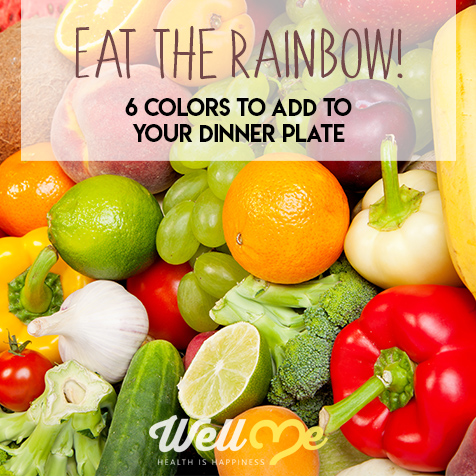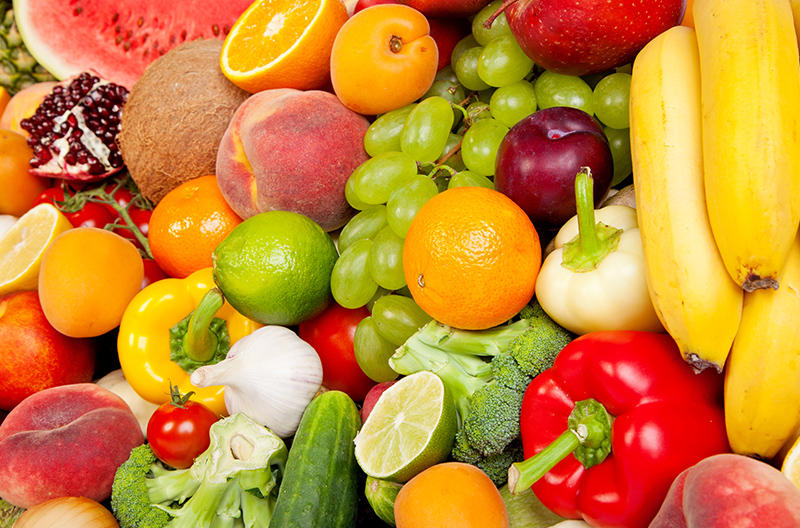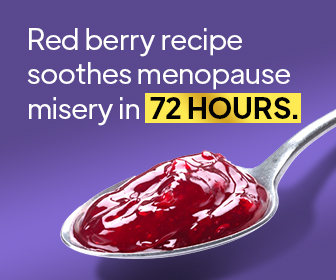It is advice you have probably heard a thousand times: make sure that you are eating every color of food. “Eating a rainbow” of different foods may seem like an adage so old it can’t possibly be rooted in science.
Well, that is just plain wrong.
As simple as it may seem, eating a wide variety of colors is a surefire way to get all the essential nutrients your body needs. If you think about it, most meats are beige or brown – that means you have to eat plenty of fruits and veggies in order to eat the rest of the rainbow. It also means that, by the time you’ve eaten every color, you have probably taken in a wide variety of healthy vitamins and nutrients.
In this article, you’ll learn the basics about what gives fruits and vegetables their color and which colors are the most beneficial for your health. So, if you’re ready to learn how to “eat the rainbow,” just keep reading!
What Are the Benefits of Colorful Foods?
When it comes to including colorful foods in your diet, a good goal is to aim for at least three different colors each day, mixing up the color combinations as often as you can. By doing this, you are expanding the range of foods that you normally consuming, eating your way to a fully balanced diet.
There are plenty of benefits to eating a colorful diet. Here are the top three:
1. First and foremost, it is simple.
While some people like diving into the scientific nitty gritty of micromanaging every single calorie, it is a task that is tiring and even intimidating for many dieters. By keeping things as simple as “more colors mean more benefits,” you can get great results with relatively little effort.
2. Another benefit is that different colors of foods provide different benefits.
By mixing things up, you can ensure that you get every nutrient your body needs. If you stick to just one or two colors (or worse yet, only artificially colored food), you are cutting yourself off from a wide world of health benefits.
3. Fruits and vegetables are the only food sources for certain benefits.
You’ll learn more about the specific benefits tied to each color in the rest of the article, but suffice it to say for now that some nutrients can only be found in fruits and vegetables. If you don’t include these foods in your diet, you could end up with a nutritional deficiency.
All of this sounds great, so why not take a closer look at what each color can offer you? You will quickly see that there are plenty of options from every single color of food, and each has the potential to provide you with something that you need.
Red
A common theme in red foods is that they provide healthy phytochemicals like lycopene and anthocyanins. In plain English, that means you will see in increase in circulatory health while also supporting your urinary tract. Here are some of the healthiest red foods to try:
Cherries are full of antioxidants. They help to prevent heart disease, diabetes, and arthritis – they also have a deliciously tart but sweet flavor! Also high in antioxidants are cranberries, which are particularly useful for keeping your urinary tract healthy and reducing inflammation throughout the body.
Tomatoes are a particularly plentiful source of lycopene which means that they are great for cardiovascular health. Tomatoes help to prevent diabetes and cardiovascular disease, and they are a fantastically versatile food that can be prepared and consumed in a number of ways.
If you are looking for a helpful source of vitamin C and fiber, you will get what you need out of red bell peppers. These can help to increase immunity and benefit digestion while also lowering cholesterol. That is a whole lot of benefits! Best of all, they can be prepared in a number of ways. Whether you are adding them to meats, throwing them into a pasta, mixing them into a salad, or baking them with some cheese, the ways to enjoy this healthy vegetable are practically limitless.
Perhaps less common but certainly plentiful in benefits, beets can provide you with a number of useful vitamins. They are fantastic for decreasing inflammation and improving digestive health as well. Other red foods to try include watermelon, apples, pomegranates, grapes, and some pears.
Green
One of the most versatile colors out there, you can get just about every flavor and health benefit by eating something green. It is the color most commonly associated with vegetables, so it stands to reason that some of the best veggies out there are green in color but there are also plenty of tasty green fruits.
Chlorophyll is the pigment that gives green foods their color. Not only does it give these foods color, but it provides many health benefits as well. Chlorophyll helps to fight cancer, improve liver detoxification, speed healing, improve digestion, and it protects your skin.
The first green food many people think of is broccoli. This cruciferous vegetable is a great source of calcium and iron which means you will be able to strengthen everything from your bones to your muscles by eating more of this vegetable. Though not always the most popular option with children, broccoli is a fantastic way to keep yourself healthy while putting some green into your diet.
Also on the list of foods with a bad reputation among children but a phenomenal reputation with health experts, spinach is best known as the source of Popeye’s big muscles. While it may not actually give you superhuman strength in the blink of an eye, it does provide plenty of benefits. Spinach comes loaded with antioxidants and vitamin K which is great for bone health.
On the sweeter side of things, kiwis are a way to get some green in the mix without the blandness that is often associated with the color green. They are high in vitamin E and glutathione, both of which are beneficial to your heart health.
For another sweet green option, try limes. They provide plenty of vitamin C while also providing fiber, calcium, iron, potassium, copper, and magnesium. With all of these benefits, it is worth your time to use lime in your salads, or try dropping a slice into your next glass of water.
Avocados are quickly becoming one of the most popular health foods around, and with good reason. They contain more potassium than bananas and plenty of fiber, plus they are great for the heart and full of useful nutrients. Another reason they are so popular is because they can be prepared in a number of ways.
There are too many great green options to list here, but if none of the above meet your fancy, you can also get great benefits from lettuce, cucumbers, Brussels sprouts, apples, grapes, asparagus, green peppers, green beans, zucchini, and many more. If there is one color that really brings everything to the dinner table, it is green.
Orange
While not quite as numerous in variety as red foods, orange options can provide you with plenty of benefits as well. Many are high in beta-carotene which provides you with vitamin A. Most orange foods also contain vitamin C, which is great for your bone health. By eating plenty of orange foods, you can increase skin and eye health, decrease your risk of cancer, and give yourself a healthy heart. With all of these benefits, it is important to mix some orange into your diet.
Everybody knows that carrots are good for your eyes. However, they are also great for your skin and beneficial to your immune system. They are a great snack if eaten plain, or you can mix them into a salad or cook them into soup.
A popular source of vitamin C, oranges are the sweet citrusy option that many people have grown to love. Don’t let them fall out of your diet as you get older, as they have many anti-aging benefits. They are great for your heart and skin, high in magnesium and fiber, and good for your bones as well.
Among the most popular of the fun fall foods, sweet potatoes can be prepared in a variety of ways and they are full of health benefits. They come packed with plenty of fiber, vitamins, iron, and antioxidants. If there is one orange food that you will get the most from keeping in your diet regularly, it would be sweet potatoes.
Foods like peaches, mangoes, apricots, and cantaloupe all come with plenty of benefits as well, making orange foods a reliable source of the things you need.
Yellow
While red and green are the big winners of the variety sweepstakes, yellow packs in a whole lot of options as well. As you will see, the kinds of foods that come in yellow are wide-ranging in both flavor profiles and nutritional benefits. You can potentially see increased immunity, improved skin health, and a decrease in cancer risk by getting yellow foods in the mix.
When you think of yellow foods, bananas may be the first that come to mind. They can help with blood pressure and heart health, but can also potentially help lower risk of diabetes and cancer – they may even increase your memory and improve your mood.
When it comes to potassium, you probably think that bananas are the best source. What you may be surprised to learn, however, is that there are many foods with more potassium than bananas! Some of the best are sweet potatoes, watermelon, beets, and butternut squash.
If you want an option with plenty of vitamins A and C, adding yellow peppers to your dietary routine may be exactly what you need. They are great for your immune system and skin, while also helping to prevent heart disease. Like the previously mentioned red peppers, they can be eaten in a variety of ways.
For a fun tropical treat, pineapples can keep things yellow and healthy whether you have them in a snack or alongside a meal. They are cholesterol- and fat-free, while also helping to regulate fluids and improving digestion. You may even see such long-term benefits as decreased chances of heart disease, cancer, cataracts, and stroke.
For an option that is about as sour as they come, mixing things up with lemons is a great way to keep the flavors fun while getting a good source of vitamin C. They are also great for your bowel health and may keep your pH levels balanced thanks to their highly acidic nature.
Blue and Purple
While there may not be as many options once you start looking for foods in the winter colors, you can still find plenty of tasty blue and purple options that are quite healthy. Many foods in these colors promote bone health while improving blood circulation.
Grapes are some of the first purple foods that come to mind (though they do come in a variety of colors). Grapes are full of antioxidants which can help to prevent cancer – they are also healthy for your heart and can help to keep your weight under control.
Blueberries are a delicious blue option. They come with plenty of fiber, vitamin K, and antioxidants, making them a perfect healthy option for a quick snack or a sweet addition to your salad. They have been shown to be beneficial to heart health and can lead to lower cholesterol.
An option that is not as sweet as some others but is perfectly purple, eggplant can be prepared in a wide variety of ways. Cooked on its own with some cheese, prepared with meat, or chopped into a salad, eggplant is one of the most versatile purple foods out there. As far as health benefits go, it is high in fiber, vitamin C, calcium, and phosphorous, so you can get a wide variety of useful nutrients by eating eggplant.
White
Don’t forget white! While it may not get the same love as other colors, it is just as important to keep plenty of organic white in your diet. White foods can give you sources of vitamin D, calcium, phosphorous, probiotics, and many more benefits. Just because they look plain doesn’t mean they taste that way! Many white foods are loaded with delicious flavor.
Just take onions as an example. One of the most useful and versatile foods out there, these can be added to a wide variety of foods to kick the flavor up to the next level, whether served cooked or raw. They can keep blood sugar low and improve heart health, provide cell protection, and slow down tumor growth. It is not hard to keep white foods in the mix thanks to onions.
Perhaps less versatile but certainly not less flavorful, garlic is one of those foods that you probably either love or hate. Well, the good news is that if you love it, you will benefit your heart with every serving.
Cauliflower is another white food that some people love and others could do without, but the health benefits are undeniable. It comes loaded with vitamin C, fights inflammation, reduces your risk of cancer, and has the potential to help your eyes.

Summary: Eating by Color Can Transform Your Health
By now you know – the most colorful foods in the world also tend to be the most nutritious! So, it only makes sense that these are the foods you should make an effort to include in your everyday diet.
If you want to improve your health, it all starts with improving your diet. You’ll be glad to know, however, that this task is easier to accomplish than you might imagine. In fact, all you really need to do is start “eating the rainbow” – just eat more foods that come in bright colors!
Action Steps: How to Maximize Your Health Benefits
- Take some time to evaluate your current diet – you might even keep a food journal for a few days to see which foods you eat most.
- Review your food journal and make note of all the colorful foods that are included – things like fresh fruits and vegetables, as mentioned above. Do you tend to eat enough of these foods or do you rely too heavily on processed foods?
- Make an effort to include more colorful fruits and vegetables in your diet by adding a piece of fruit to breakfast and lunch every day.
- Boost your intake of colorful foods by preparing homemade smoothies using fresh fruits and veggies – enjoy these smoothies as snacks between meals or as a meal replacement option.
No matter how you go about it, it is a good bet that you’ll be healthier if you start adding every color of the rainbow to your diet. With all of these healthy and delicious options available to you, it shouldn’t just be easy, it should be enjoyable!








